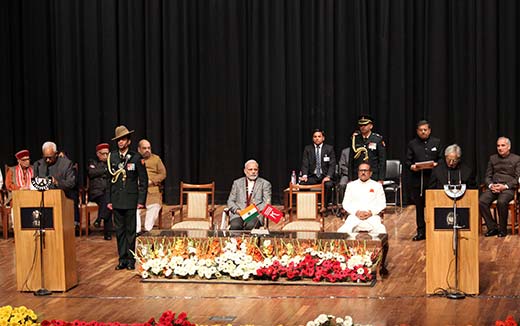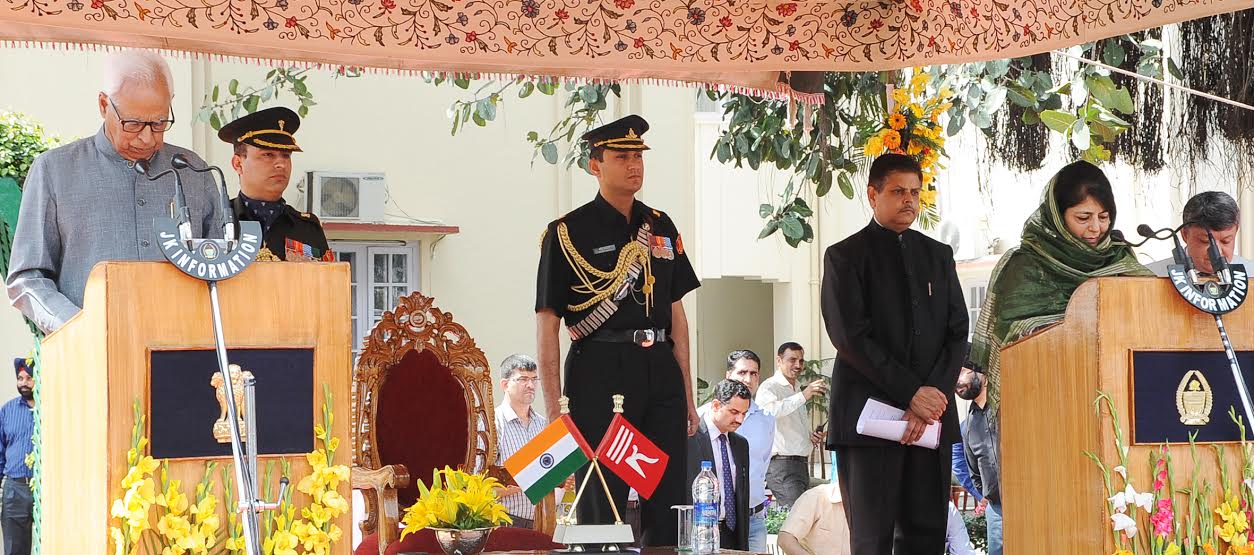As the tensions over the Kathua rape and murder are spreading far and wide and the government is planning a cabinet reshuffle with at least half a dozen faces, Tasavur Mushtaq revisits the unmaking of Agenda of Alliance at a time when the ruling coalition’s half-year term is over

Last time when Chief Minister Mehbooba Mufti flew to Delhi, it was February 27, 2018. After meeting home and finance ministers, she had a meeting with Prime Minister Narendra Modi.
Situation and development apart, the underlying point in all the meetings was her insistence on implementation of Agenda of Alliance (AoA). And this was not the first time she urged its implementation. This time, what made the insistence special, was that it was literally on eve of BJPDP government conclusion of half term.
March 1, 2015, created history in Jammu and Kashmir when two ideologically opposite parties, Peoples Democratic Party (PDP) and Bharatiya Janata Party (BJP) stitched an alliance paving way for Mufti Muhammad Sayeed’s take-over as 12th Chief Minister.
In anticipation of oath-taking by 25-member council, the two parties had protracted discussions between Ram Madhav (BJP) and Dr Haseeb Drabu (PDP).
The two men took more than 60 days in Delhi and Mumbai to manage discord. More than half a dozen ‘drafts’, later, when AoA came into being, many said it was Instrument of Accession 2.0. It was termed to be the “guiding framework” for the coalition government’s six years of ‘governance’ and done to “convert the complex challenge into an opportunity”.
Though halftime is over, AoA implementation is still a major concern. Even a committee of Group of Ministers (GoM) to oversee its implementation has failed to reach a consensus in the three times – twice in 2015 and once in November 2017, so far. The coalition supposed to implement AoA has proved it’s unmaking.
Governance Reforms
AoA wanted to transform “State Government into a Smart Government which will be proactive, transparent and accountable”. Three years later, the deficit is visible.
Aiming to enable business and to rope in strategic partners in long-term partnerships, only two visible things have happened. Anil Ambani announced in November 2015, after meeting Chief Minister, to set up a 1000-seater call centre in J&K. Recently, Finance Minister Dr Drabu, playing host to Dubai Ports (DP) CEO for a dry port. PPP policy is in place but it is gathering dust.
AoA suggested making J&K the most “ethical” state in India as its ‘mission’. Providing “honest, effective inclusive governance and service delivery” has remained on AoA. Three years later, the partners are fighting individually for worst nepotism. Public Service Commission has not been able to complete a single process of J&K Combined Competitive Examination, so far.
Education is fundamental to life. The Kashmir University may have to give postgraduate courses a miss in 2018 as no fresh batch is eligible to apply. The reason: the introduction of semester system and then delay in holding examinations. The Central University coming up in Ganderbal swamps is still without a proper address.
Seemingly, AoA is overridden by an ‘unwritten rule’: Jammu is for BJP and Kashmir for PDP. A BJP minister went against the cabinet decision of having a Muslim police officer in his area. It created a situation that Mehbooba left the cabinet meeting.
A new battle was forced on SKIMS. Its director was removed for ‘dismal performance’, rehabilitated elsewhere and then dumped literally. Apprehending a similar situation, the then GMC Srinagar principal put in his papers and went home. The half term would be known for the mass transfers.
Political Initiatives
AoA wanted to “initiate several steps to normalize the relationship with Pakistan and create a reconciliatory environment” and the intense cross-border clashes sum up everything. Last two months recorded the highest hostility between rival armies.
The idea of better bilateral relations was hit twice. Once by Prime Minister when he publicly rebuffed Mufti saying he does not require a counsel. Recently AoA co-author hit Mehbooba. “If the CM feels India-Pakistan talks will help contain infiltration and bring peace in the Valley, allow her to have her view,” Ram Madhav told Indian Express. “But she is not going to decide it”.
The two parties dissented over the use of ‘Hurriyat’ in AoA but eventually, it figured in the document. However, this did not help the “Hurriyat” come out of the “house arrest”, so far. Srinagar’s Jamia Masjid made more news because of its closure than the routine it historically has.
In the last year of the half term, Delhi appointed Dineshwar Sharma as its point man. Five visits later, Sharma works like a bureaucrat and a grievance collector. Now even he believes: “civilian killings have to stop”. PDP’s ‘battle of ideas’ was redefined by the house arrests and NIA actions in the state, its detractors believe.

Security Matters
The peace and normalcy dividends could not trickle down because it did not take place. Vocal about the revocation of Armed Forces Special Powers Act (AFSPA), Mehbooba Mufti now says “time is not ripe”. The feel-good factor of erstwhile PDP government of 2002 has been reversed with the opposition accusing that the ‘dreadful’ days of early 1990’s have returned to haunt the Vale.
BJP used the migration Kashmir Pandits in all states. They still live far away from their homes. Interestingly, the Government has restarted “migrant registration” in Jammu after around eight years.
Unlike Pandits, the BJP did not forget the West Pakistan refugees and Displaced Persons. They got them Rs 2000 crore under Prime Minister’s Package.
What was genuinely historic was the regularization of not less than 60,000 daily wagers. Though lost in the din of nepotism, this intervention was not the one in AoA.
Developmental Agenda
Under AoA, Dulhasti and Uri power projects were supposed to return to J&K from NHPC as was earlier suggested by a Working Group that C Rangarajan led. Power minister R K Singh said, “no power projects will be returned to the state”. His predecessor Piyush Goyal bluntly opposed the demand, insisting: “states put forward a lot of demands to the centre, but demands cannot be translated into decisions.”
Projects like “rebuilding Shehr-e-Khaas as a heritage destination, making Dal lake a world heritage site and develop, preserve, and promote the Dogra Heritage and Ladakh’s Hemis festival” might now find some priority in the second half. The agenda of making Jammu and Srinagar as smart cities apart, the government has not even initiated the key urban reforms, yet.
AIIMS is announced for Srinagar but still not taking off. The Mughal road continues to have the same sluggish velocity. Wullar and Dal lake continue to exhibit the age-old dullness.
In public finances, however, the government exhibited some shifts. But that is beyond AoA.
The journey, so far…
When the government took over with 11 PDP men holding ministerial berths in a 17-member cabinet, it sent a message that “the government was tilted towards PDP.” A few hours later, Mufti credited Pakistan, Hurriyat, and militants for “allowing conducive atmosphere” for the conduct of assembly polls, one of the most participated after 1987.
The idea, according to close aides of Mufti, was to “bridge the differences and introduce Kashmir to the idea of India.” His ‘thanksgiving’ was an attempt to send out the message of reconciliation and reiterating his agenda of working out for the larger constituency of peace, but BJP cut that bid short and reacted. Since then, no complete election was held. Srinagar parliamentary election recorded 7 percent turnout paving way for south Kashmir cancellation. Now, Panchayat Polls were deferred.
Within days of Mufti’s takeover, Masarat Aalam was released by the court. PDP packaged it as part of its ‘battle of ideas’. Within days, BJP pulled the strings with BJP President Amit Shah insisting the party will pull out from the coalition if national security was compromised. Alam remains incarcerated, 36 PSA’s later. Modi’s November 8, 2015, the statement put a cap on it when he reacted to Mufti’s suggestion in Srinagar. On Kashmir, Prime Minister said, “I don’t need anybody’s advice or analysis from anywhere.”
Later that year, Mufti fell ill and passed away at AIIMS. Modi paid his last respects at the airport.
An “opposition leader” dubbed “soft-separatist”, when Mehbooba, got the reigns of PDP, she was caught on the wrong foot. Mourning the loss, she felt bad for Modi not coming to condole, especially after Sonia Gandhi did. Soon, she understood the “difficulties” in continuing the alliance. “She was aware of how late Mufti was not allowed to do what he had in his mind,” her aides say. She took her time, but finally decided to take over. In a way, insiders said, it was involuntary because BJP was hobnobbing with most of her lawmakers, some of whom went public against “messing the mandate”.
In April 2016, when Kashmir’s first women Chief Executive took-over, the pulls and pressures were stark. By then, BJP had learned the art of managing its ally.
NIT Srinagar came so handily as the first crisis in which BJP wanted to play the role. Then tinkering with the Special status started taking the judicial route to abrogate article 35A, besides applying new laws related to business and finance, an issue still undecided in the court.
Almost 14 months later, Burhan Wani was killed in an encounter and Kashmir plunged into serious crisis: 117 were killed and more than 10,000 injured. Politics took a back seat as police introduced the pellets on a mass scale. Mehbooba literally rose from south Kashmir, her bastion. Now, it is her biggest challenge.
Post-Burhan, Kashmir is completely different. The crackdowns have returned with a new packaging: Cordon and Search Operations (CASO). In 2017, security grid killed 218 militants, a record number in last seven years. Police said locals picking up guns rose by 44 percent taking total up to 126.
In 2015, 113 militants were killed, a number that crossed 165 in 2016. In 2018’s 75 days, 37 militants stand already lowered in graves.
Justifying the coalition, Mufti had said it will ‘bridging’ the regions: Kashmir and Jammu. Now regions are pitted against each other. Most of Jammu barely has a Muslim officer. The only solace that PDP draws is that Amarnath killings did not see a nasty follow up.
Recently when JAKLI’s Sunjuwan base in Jammu was attacked, assembly’s speaker, Kavinder Gupta pointed fingers towards the few hundred families of Rohingyas refugees. Though he ate his words in the assembly, Defence Minister Nirmala Sitharaman visited the camp and insisted: “the demography of the cantonment and adjoining areas” had helped militants. It was an oblique reference to the local Muslim minority.
It is the same plot in play in Kathua where a Muslim Gujjar girl was kidnapped, raped, murdered and later forced to be buried far away from her home. Now state police have found its own men involved in the crime.
A heinous crime has divided the coalition: BJP wants the case to go to CBI because it does not believe state police. Two cabinet ministers joined a newly floated Hindu Ekta Munch seeking the transfer despite knowing that Munch members are directly involved. “It has been made into a huge case,” one minister admitted. “I do not know which far will it take the state?”
On January 27, firing in which three civilians were killed, Mehbooba said the “FIR was filed after consulting defence minister Nirmala Sitharaman”. Reactions came from her deputy, Dr Nirmal Sigh: “We are fighting a proxy war… What the Army men did, woh unka right hai (It is their right). This is the government stand too.”
Omar Abdullah, the NC leader, says terms the “one step forward-two steps backwards” as the “dance by the PDP and BJP”.

